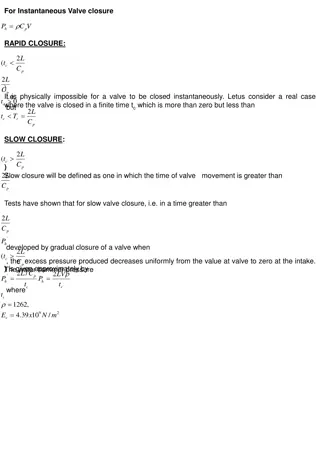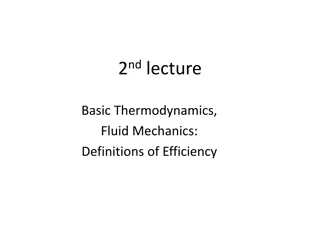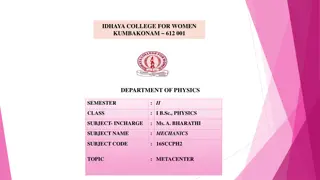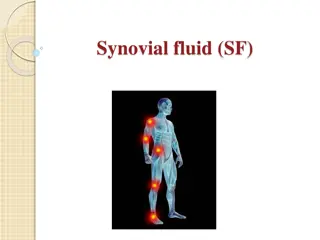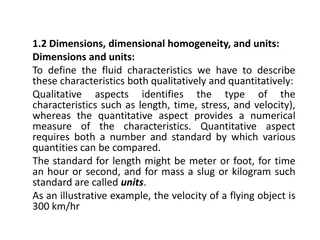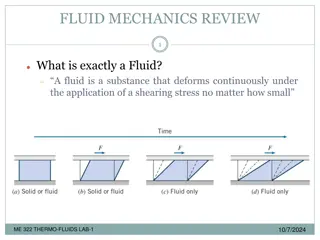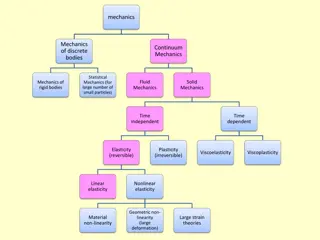Understanding Material Derivative in Fluid Mechanics
Fluid flows are described using Eulerian kinematics and material derivative concepts, highlighting the changes in scalar and vector fields. The acceleration and components of material acceleration are explored, along with visualizations of material acceleration. Trajectories and displacements of fluid parcels are discussed in both steady and unsteady flows, with a focus on streamlines, pathlines, and streaklines.
Download Presentation

Please find below an Image/Link to download the presentation.
The content on the website is provided AS IS for your information and personal use only. It may not be sold, licensed, or shared on other websites without obtaining consent from the author. Download presentation by click this link. If you encounter any issues during the download, it is possible that the publisher has removed the file from their server.
E N D
Presentation Transcript
Eulerian Kinematics of Fluid Flows P M V Subbarao Professor Mechanical Engineering Department A Framework to Describe Simultaneous Motion of MultitudinousParcels
Understanding of Material Derivative of A Scalar Field ?? =?? ???? + ?? The operator D represents the substantial or material change of the quantity T(t:x,y,z). The first term on the righthand side of above equation represents the local or temporal change of the quantity T(t:x,y,z) ata fixed position vector x. The operator d symbolizes the convective change of the same quantity with respect to x at a fixed instant of time. The convective change of T(t:x,y,z) may be expressed as: ?? =?? ???? +?? ???? +?? ???? ?? = ? ? ?
Understanding of Material Derivative of A Vector Field Eulerian Velocity vector is defined as : ? = ? ?:?,?,? ? + v ?:?,?,? ? + w ?:?,?,? ? Sustantial or Material Derivative of Velocity vector is defined as : ?? =?? ?? = ? ? ? ???? + ?? ?? as the gradient of the vector field which is a second order tensor. ?? ?? ?? ?? ?? ?? ?? ?? ?? ?? ?? ?? ?? ?? ?? ?? ? = ?? ??
Rate of Change of Material Derivative of A Vector Field ?? =?? ???? + ?? Dividing above equation by dt yields the acceleration vector. ?? ??=?? ??+?? ?? ??=?? ??+? ? ?? ? ?? The differential dt may symbolically be replaced by Dt indicating the material character of the derivatives. ?? ??=?? ??+ ? ? ? =?? Material or substantial acceleration ??+ ? ?
Components of Material Acceleration ? =?? ??+ ? ? ??=?? ??+ ??? ??+ ??? ??+ ??? ??=?? ??+ ??? ??+ ??? ??+ ??? ?? ?? ??=?? ??+ ??? ??+ ??? ??+ ??? ?? ?? ?? ?? ?? ?? ?? ?? ?? ?? ?? ???? ?? ?? ?? ?? ?? ?? ?? ?? ?? ?? ?? ?? ?? = + ? ? ? ?? ??
Trajectories or Displacement of Fluid Parcels A steady velocity flow will have only one type of trajectory/displacement function for entire flow field. It is same as Lagrangian displacement. A general unsteady flow in a Eulerian perspective defines three types of trajectories/ displacement functions for fluid parcels: Streamlines Pathlines Streaklines. They are all equivalent for steady flows but differ conceptually for unsteady flows.
Eulerian Trajectory of Fluid Parcel: Streamline Streamline equation: A streamline is defined as a line which is everywhere parallel to the local velocity vector ? = ? ?:?,?,? ? +v ?:?,?,? ? + w ?:?,?,? ? Define an infinitesimal displacement vector, known as an infinitesimal arc segment along a streamline as ?? = ?? ? +dy ? + dz ? Since this arc segment along the streamline is parallel to velocity vector, a vector operation may be defined as: ?? ? = ?? ? +dy ? + dz ? ? ?:?,?,? ? +v ?:?,?,? ? + w ?:?,?,? ? =0
Equation for Streamline ?? ? = ?? ? +dy ? + dz ? ? ?:?,?,? ? +v ?:?,?,? ? + w ?:?,?,? ? =0 Separately set each component to zero to get three differential equations which define the streamline. The three velocity components u, v, w, must be expressed as functions of x, y, z before these equations can be integrated. To set the constants of integration, it is sufficient to specify some point xo, yo, zo through which the streamline passes,
Two-Dimensional Streamline In 2-D, dz = 0 and w = 0, and only the k component of the equation above is non-trivial. ?? ? = ?? ? +dy ? ? ?:?,?,? ? +v ?:?,?,? ?= 0 It can be written as an Ordinary Differential Equation for the streamline shape y(x). ?? ?=?? ? u(t: x, y) and v(t: x, y) must be known to allow integration. xo, yo must be given to set the integration constants. In a numerical integration, xo, yo would serve as the initial values. https://web.mit.edu/16.unified/www/FALL/fluids/Lectures/f08.pdf
DaVinci View of 2D Streamlines In 2-D, a stream tube is defined by considering any two streamlines passing through two different (xo, yo) points.
DaVinci View of 2D Streamlines The flow between these two streamlines carries the same mass flow/span at each cross-section.
DaVinci View of 2D Streamlines This can be considered as a 2-D channel flow embedded in the rest of the flow field.




